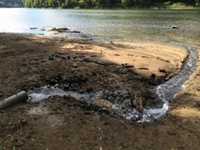Advertisement
Grab your lab coat. Let's get started
Welcome!
Welcome!
Create an account below to get 6 C&EN articles per month, receive newsletters and more - all free.
It seems this is your first time logging in online. Please enter the following information to continue.
As an ACS member you automatically get access to this site. All we need is few more details to create your reading experience.
Not you? Sign in with a different account.
Not you? Sign in with a different account.
ERROR 1
ERROR 1
ERROR 2
ERROR 2
ERROR 2
ERROR 2
ERROR 2
Password and Confirm password must match.
If you have an ACS member number, please enter it here so we can link this account to your membership. (optional)
ERROR 2
ACS values your privacy. By submitting your information, you are gaining access to C&EN and subscribing to our weekly newsletter. We use the information you provide to make your reading experience better, and we will never sell your data to third party members.
Environment
Earthquakes and Fracking Activities Linked In Environmental Protection Agency Report
Disposal of wastewater from oil and gas drilling can trigger small temblors
by Jessica Morrison
February 13, 2015
| A version of this story appeared in
Volume 93, Issue 7
Increasingly, wastewater from oil and gas operations is pumped into the ground for disposal, and the pressure it creates might be causing small earthquakes, says a report released by EPA.

Concern about a connection between wastewater injection and seismic activity arose following a series of earthquakes in 2011, says Peter C. Grevatt, director of EPA’s Office of Ground Water & Drinking Water. “We thought it was very timely to ask a group of experts to look into this issue.”
The report was prepared by the Underground Injection Control National Technical Workgroup, a group of regional and state experts.
Advanced oil and gas recovery techniques, which include horizontal drilling and hydraulic fracturing, bring ancient seawater to the surface along with oil and gas. At the surface, the brine and other wastes are separated from the economically valuable hydrocarbons. The water’s high salinity renders it too expensive to treat and discharge at the surface. Instead, it is often injected into deep wells for disposal. Over time, as pressure builds underground, release through ground-shaking tremors is possible, researchers say.
“Where individual cases of suspected induced earthquakes have been studied, the common denominator has been one or more high-volume injections wells,” says William L. Ellsworth, a seismologist with the U.S. Geological Survey, who is not a member of the workgroup.
The workgroup studied sites where wastewater injection is suspected of causing small to moderate earthquakes. It evaluated earthquake history, the proximity of disposal wells to these events, and the behavior of the wells.
“It’s very difficult to conclusively link any particular injection activity with a seismic event,” Grevatt says.
A series of Oklahoma quakes in 2011 with magnitudes greater than 5.0 brought attention to a possible connection between hydraulic fracturing and induced earthquakes. A recent study called one of these earthquakes, with a magnitude of 5.7, the largest yet associated with wastewater injection (J. Geophys. Res. 2014, DOI: 10.1002/2013jb010612).
The report offers guidance to state and federal officials who want to minimize and manage seismic activity that might be a result of injection, the agency says.



Join the conversation
Contact the reporter
Submit a Letter to the Editor for publication
Engage with us on Twitter